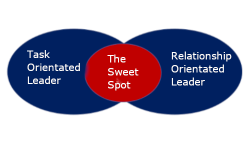It has become increasingly obvious that effective leadership is hugely important in the workplace. If the leadership is not effective, problems such as poor productivity, low motivation and high turnover can occur. In the current market, there are many new opportunities available for employees and so if employees are not happy it is very likely that they will go elsewhere. Leaders often don’t think about the type of leader they are. Generally they fall into either the task-oriented or relationship-oriented leadership style.
Task Oriented Leadership
This type of leader focuses on the tasks that needed to be carried out in order to reach goals. The leadership style here can be described as autocratic. Autocratic leaders don’t involve their team in decision making. Task-orientated leadership involves some task management features. This involves placing emphasis on administrative activities, co-ordinating job-related activities, preparing financial reports etc. As we can see leaders who opt for this style focus on completing tasks in order to reach targets. This type of leader doesn’t really care about relationship building or the employees who are needed to reach these goals. They are more concerned with following their plan to reach organisational targets.
One of, if not the biggest strength of this type of leadership is that all tasks are completely to a high standard in a timely manner. These leaders set an example for employees by focusing on the necessary procedures in relation to how tasks as completed. As a result, they can delegate work and make sure that tasks are completed on time to a high standard. This style of leadership would be suitable in well-structured environments like for example manufacturing assembly lines where repeating well-defined processes produces high levels of both productivity and quality.
Some of the weaknesses associated with this leaderships style involve a fear of breaking the rules among employees, this may lead to a lack of creativity, low morale and as a result high turnover. A lack of innovation which can come from a fear of taking risks, means employees who are naturally creative can become demoralised and eventually leave the organisation to find a more appealing opportunity.
Relationship-Oriented Leadership
This type of leadership focuses on creating success as a result of building lasting relationships with employees and the motivation, job satisfaction and work-life balance of their employees. They still care about getting tasks done, however they believe that work culture is more important. Leaders who use this style concentrate on motivating, supporting and developing their employees. Relationship oriented leaders also promote collaboration and teamwork, by encouraging communication and building positive relationships. The welfare of employees is the top priority for these leaders and as a result, they put time and effort into meeting their employees individual needs.
One of the strengths of this leadership style is that these leaders establish teams that all employees want to be a part of. Members of these teams are often more productive and willing to take risks because they understand that they will get support from the leader if necessary. Another strength is that employees are in an environment where they know their leader cares about there welfare. These leaders know that work place productivity requires creating a positive environment where employees feel motivated. As a result, these leaders prioritise people in order to ensure that issues such as personal conflicts, dissatisfaction and turnover are low.
One of the weaknesses of this leadership style is that focusing on creating team spirit may get in the way of completing tasks and reaching goals. Some leaders can put the development of their team above tasks.
Over the years, studies have been conducted in order to determine if one type is better than the other, however no one behaviour is instrumental to the success of a leader in every situation. The dynamic nature of leadership determines that if a leader is effective, they should be able to balance both types of leadership styles which should be applied in response to a particular situation. This involves some level of self-awareness, you need to work out which style you fall under and take note of when you may need to change up your style to suit a particular situation. If for example you are task oriented you need to soften up, this can be difficult, but it is very important. Start by trying to brush up on your ‘soft’ skills such as listening. For relationship-oriented leaders, they need to do the opposite and toughen up. This could be by being more decisive and setting standards.
Penn State (2013) Balancing Task and Relationship Behaviors [online] https://sites.psu.edu/leadership/2013/05/20/balancing-task-and-relationship-behaviors/
Bell, S. (2017) Task-Oriented vs. People-Oriented Leadership Styles [online] https://bizfluent.com/info-12137619-taskoriented-vs-peopleoriented-leadership-styles.html
Larman, A. (2015) Task-Oriented Vs People-Oriented Leadership Styles [online] http://ezinearticles.com/?Task-Oriented-Vs-People-Oriented-Leadership-Styles&id=9253531
Ruzgar, N. (2018) The Effect of Leaders’ Adoption of Task-Oriented or Relationship-Oriented Leadership Style on Leader-Member Exchange (LMX), In the Organizations That Are Active In Service Sector: A Research on Tourism Agencies. Journal of Business Administration Research. Vol 7:1 pp50-60

